Why ggplot2?
Per John Burn Murdoch of the FT:
ggplot2is awesome because:
- It takes minimal time and effort to audition multiple different ideas for a graphic, and to iterate on them
- It gets people thinking in the continuous visual encoding space, rather than the discrete chart-type space
Breaking that down
ggplot2(and R) is fantastic for exploratory data analysisggplot2is an application of the "Grammar of Graphics", rather than a "make this chart" tool
A grammar of graphics
A grammar of graphics
Images from John-Burn Murdoch's presentation: ggplot2 as a creativity engine
Easy enough to rapidly prototype graphics at the "speed of thought"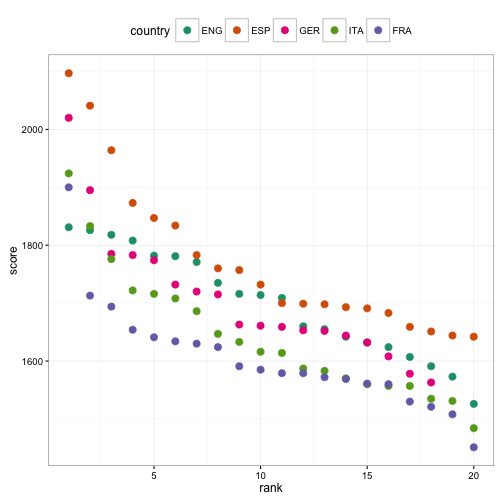
A grammar of graphics
Images from John-Burn Murdoch's presentation: ggplot2 as a creativity engine
Easy enough to rapidly prototype graphics at the "speed of thought"
Powerful enough for final "publication"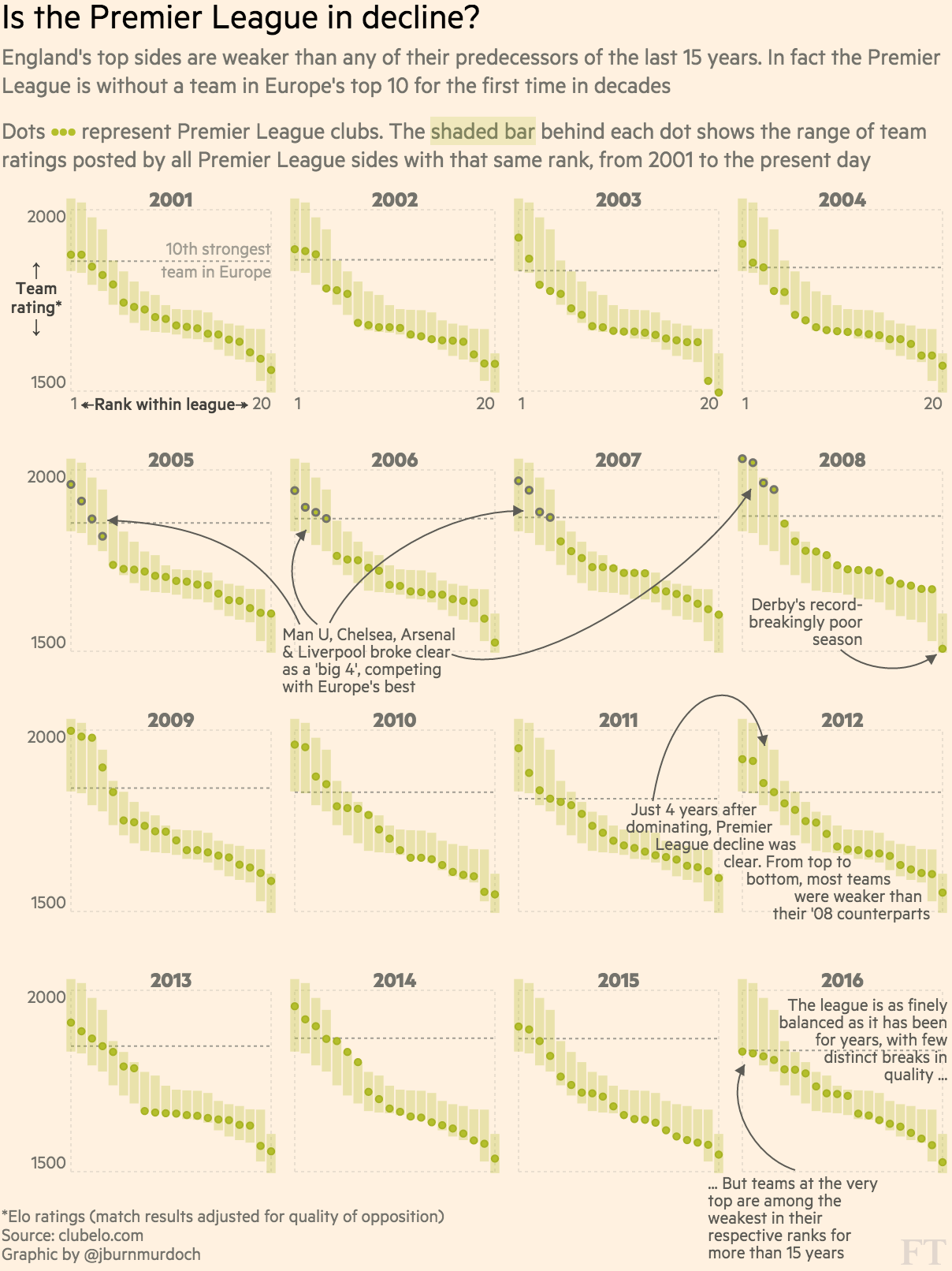
BBC's ggplot2 cookbook
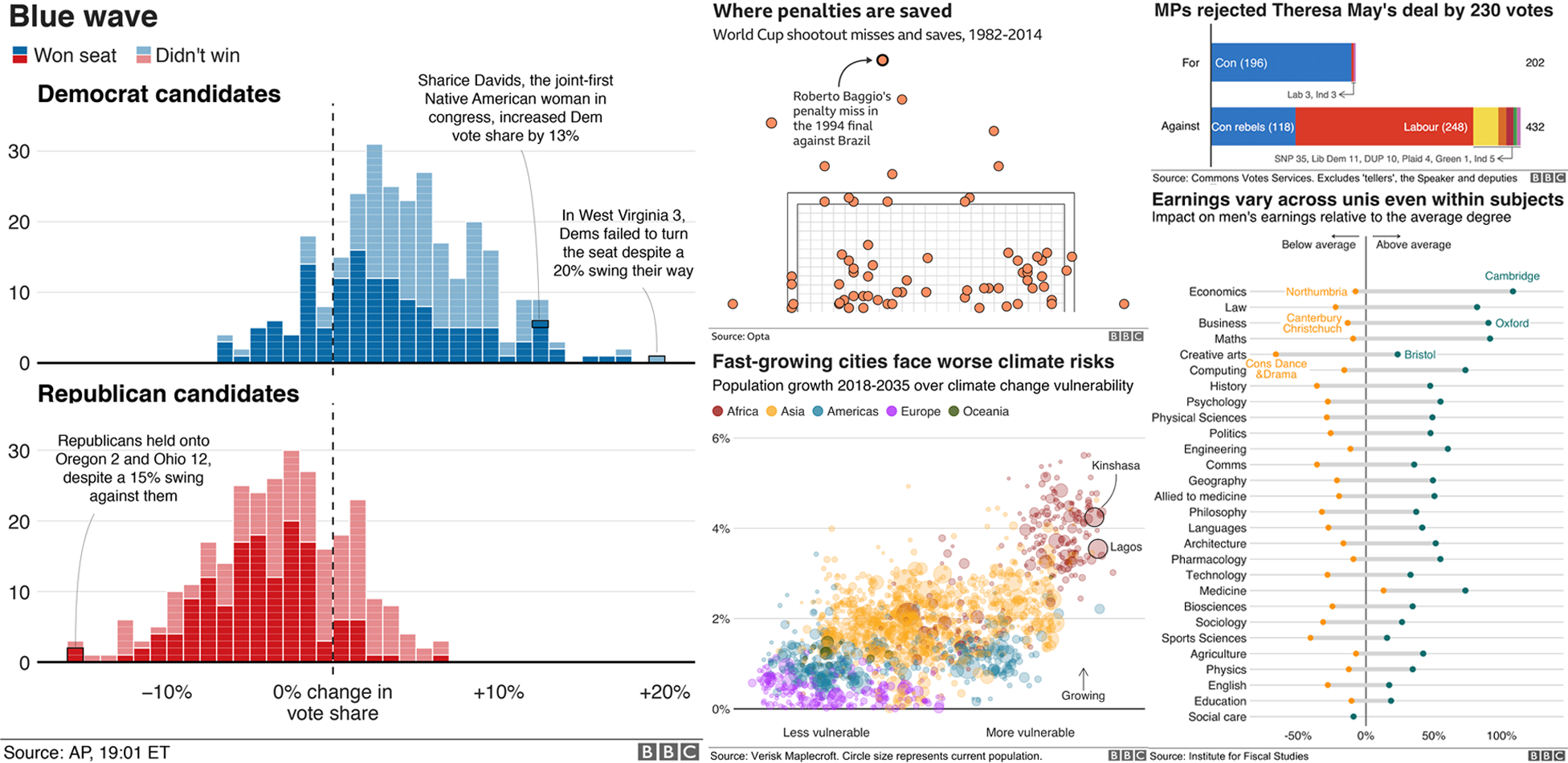
Coding time!
Data Prep
A few datasets to start us off
diff_df <- readr::read_csv("https://raw.githubusercontent.com/jthomasmock/radix_themockup/master/static/diff_df.csv")combo_pass <- readr::read_csv("https://raw.githubusercontent.com/jthomasmock/radix_themockup/master/static/combo_pass.csv")glimpse(diff_df)## Rows: 224## Columns: 7## $ year <dbl> 2014, 2014, 2014, 2014, 2014, 2014, 2014, 2014, 2014, 201…## $ conf <chr> "AFC", "AFC", "AFC", "AFC", "AFC", "AFC", "AFC", "AFC", "…## $ team_name <chr> "Patriots", "Broncos", "Steelers", "Colts", "Bengals", "R…## $ abb_name <chr> "NE", "DEN", "PIT", "IND", "CIN", "BAL", "KC", "HOU", "SD…## $ logos <chr> "https://a.espncdn.com/i/teamlogos/nfl/500/scoreboard/ne.…## $ win_percent <dbl> 0.75000, 0.75000, 0.68750, 0.68750, 0.65625, 0.62500, 0.5…## $ differential <dbl> 155, 128, 68, 89, 21, 107, 72, 65, 0, 54, 15, -38, -118, …Back to basics
basic_plot <- ggplot(diff_df, aes(x = differential, y = win_percent)) + geom_point()basic_plot
Built in themes
basic_plot + theme_minimal()
Built in themes
basic_plot + theme_bw()
ggthemes themes
basic_plot + ggthemes::theme_fivethirtyeight()
ggthemes themes
basic_plot + ggthemes::theme_economist()
Manual theme
basic_plot + theme( panel.grid.major = element_line(color = "red"), axis.text.x = element_text(size = 20, color = "red"), plot.background = element_rect(fill = "lightblue"), panel.background = element_rect(fill = "blue") )
theme() elements
For the theme elements, there are:
element_line()- change line element components, takes arguments like color, size, linetype (dotted, dashed, solid, etc)element_rect()- change rectangular components like plot backgrounds, legend backgrounds, etc, takes arguments like fill, color, sizeelement_text()- change text components like axis labels, titles, and takes arguments like family (font family), face (bold, italics, etc), hjust/vjust (horizontal or vertical alignment), color, etcelement_blank()- completely remove an element by namemargin()- adjust margins of an element, can be used within some other theme componenets, and takes arguments of t (top), r (right), b (bottom), l (left), and unit (unit such as points, in, cm, etc)rel()- relative sizing of elements, useful for text especially, ie choosing a base font size and scaling the titles vs body fonts relative to each other
Inspiration
"Steal like an artist"
Your job is to collect good ideas. The more good ideas you collect, the more you can choose from to be influenced by.
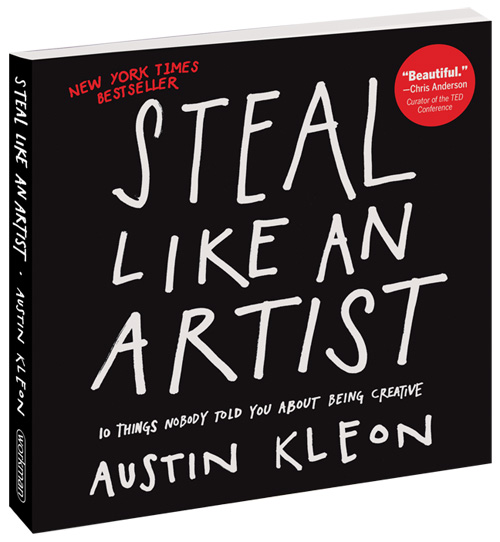
A personal favorite
I love FiveThirtyEight's graphics and tables, as such we'll try to recreate some of their graphics. We're going to "steal like an artist"
A personal favorite
I love FiveThirtyEight's graphics and tables, as such we'll try to recreate some of their graphics. We're going to "steal like an artist"
Key elements
- Focus on Web, ie relatively small graphics
- Light smoke-grey background with grey gridlines
- Black Plot Titles/Subtitles and Axis Labels
- Grey axis text (ie numbers on axis)
- LARGE plot titles and axis labels, with medium subtitles and axis text
- Opinionated fonts
- Always add a source
- Bright, high-contrast colors for plots
FiveThirtyEight

More FiveThirtyEight


Create your own theme
theme_538 <- function(base_size = 12, base_family = "Chivo") { theme_grey(base_size = base_size, base_family = base_family) %+replace% theme( # drop minor gridlines and axis-ticks panel.grid.minor = element_blank(), axis.ticks = element_blank(), # change font elements/family text = element_text(family = "Chivo", size = base_size), axis.text = element_text(face = "bold", color = "grey", size = base_size), axis.title = element_text(face = "bold", size = rel(1.33)), axis.title.x = element_text(margin = margin(0.5, 0, 0, 0, unit = "cm")), axis.title.y = element_text(margin = margin(0, 0.5, 0, 0, unit = "cm"), angle =90), plot.title = element_text(face = "bold", size = rel(1.67), hjust = 0), plot.title.position = "plot", plot.subtitle = element_text(size = 16, margin = margin(0.2, 0, 1, 0, unit = "cm"), hjust = 0), plot.caption = element_text(size = 10, margin = margin(1, 0, 0, 0, unit = "cm"), hjust = 1), # change plot colors for the background/panel elements plot.background = element_rect(fill = "#f0f0f0", color = NA), panel.background = element_rect(fill = "#f0f0f0", color = NA), panel.grid.major = element_line(color = "#d0d0d0"), panel.border = element_blank(), # shrinks margin and simplify the strip/facet elements plot.margin = margin(0.5, 1, 0.5, 1, unit = "cm"), strip.background = element_blank(), strip.text = element_text(size = rel(1.33), face = "bold") )}A dataviz journey
nfl_stand <- 2014:2020 %>% map_dfr(espnscrapeR::get_nfl_standings)nfl_stand_plot <- nfl_stand %>% ggplot(aes(x = pts_diff, y = win_pct)) + geom_point() + geom_smooth(method = "lm")nfl_stand_plot## `geom_smooth()` using formula 'y ~ x'
Color by playoffs
nfl_stand_prep <- nfl_stand %>% mutate( color = case_when( season < 2020 & seed <= 6 ~ "blue", season == 2020 & seed <= 7 ~ "blue", TRUE ~ "red" ) )nfl_stand_prep## # A tibble: 224 x 29## conf season team_id team_location team_name team_abb team_full team_logo ## <chr> <dbl> <dbl> <chr> <chr> <chr> <chr> <chr> ## 1 AFC 2014 17 New England Patriots NE New Engla… https://a.e…## 2 AFC 2014 7 Denver Broncos DEN Denver Br… https://a.e…## 3 AFC 2014 23 Pittsburgh Steelers PIT Pittsburg… https://a.e…## 4 AFC 2014 11 Indianapolis Colts IND Indianapo… https://a.e…## 5 AFC 2014 4 Cincinnati Bengals CIN Cincinnat… https://a.e…## 6 AFC 2014 33 Baltimore Ravens BAL Baltimore… https://a.e…## 7 AFC 2014 12 Kansas City Chiefs KC Kansas Ci… https://a.e…## 8 AFC 2014 34 Houston Texans HOU Houston T… https://a.e…## 9 AFC 2014 24 San Diego Chargers SD San Diego… https://a.e…## 10 AFC 2014 2 Buffalo Bills BUF Buffalo B… https://a.e…## # … with 214 more rows, and 21 more variables: seed <dbl>, wins <dbl>,## # losses <dbl>, win_pct <dbl>, g_behind <dbl>, ties <dbl>, pts_for <dbl>,## # pts_against <dbl>, pts_diff <dbl>, streak <dbl>, div_ties <dbl>,## # record <chr>, home_wins <dbl>, home_losses <dbl>, away_wins <dbl>,## # away_losses <dbl>, conf_wins <dbl>, conf_losses <dbl>, div_wins <dbl>,## # div_losses <dbl>, color <chr>Color by playoffs
nfl_stand_prep %>% ggplot(aes(x = pts_diff, y = win_pct)) + geom_vline(xintercept = 0, size = 0.75, color = "#737373") + geom_point(aes(color = I(color)))
Add text
nfl_stand_prep %>% ggplot(aes(x = pts_diff, y = win_pct)) + geom_vline(xintercept = 0, size = 0.75, color = "#737373") + geom_point( aes(color = I(color)), size = 3, alpha = 0.8 ) + labs(x = "Points Differential", y = "Win Percent", title = "Playoff teams typically have a positive point differential", subtitle = "Data through week 17 of the 2020 NFL Season", caption = "Plot: @thomas_mock | Data: ESPN")Add text
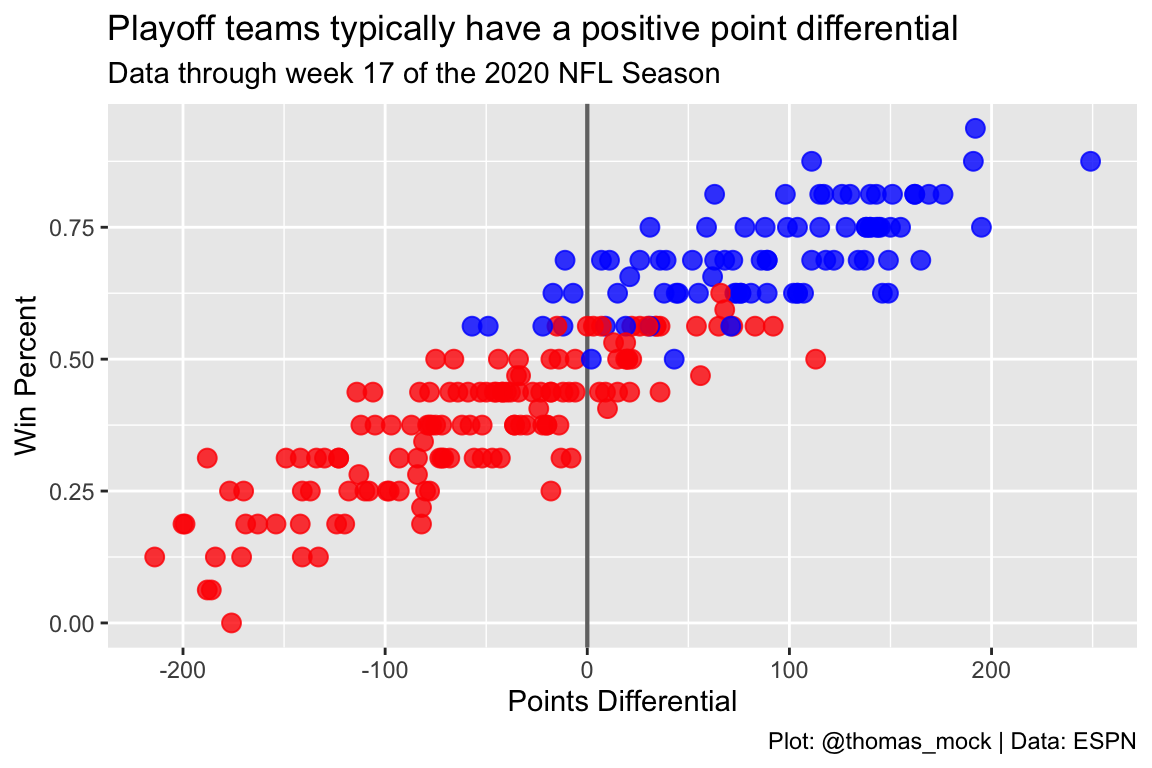
Refine labels
First create a helper dataset, we'll use it for annotations later.
library(ggtext)# create a tiny datasetplayoff_label_scatter <- tibble( differential = c(25,-70), y = c(0.3, 0.8), label = c("Missed<br>Playoffs", "Made<br>Playoffs"), color = c("#D50A0A", "#013369"))nfl_stand_refine <- nfl_stand %>% mutate( color = case_when( season < 2020 & seed <= 6 ~ "#013369", season == 2020 & seed <= 7 ~ "#013369", TRUE ~ "#D50A0A" ) )Refine labels
playoff_diff_plot <- nfl_stand_refine %>% ggplot(aes(x = pts_diff, y = win_pct)) + geom_vline(xintercept = 0, size = 0.75, color = "#737373") + geom_hline(yintercept = 0, size = 0.75, color = "#737373") + geom_point( aes(color = I(color)), size = 3, alpha = 0.8 ) + ggtext::geom_richtext( data = playoff_label_scatter, aes(x = differential, y = y, label = label, color = I(color)), fill = "#f0f0f0", label.color = NA, # remove background and outline label.padding = grid::unit(rep(0, 4), "pt"), # remove padding family = "Chivo", hjust = 0.1, fontface = "bold", size = 8 ) + labs(x = "Points Differential", y = "Win Percent", title = "Playoff teams typically have a positive point differential", subtitle = "Data through week 17 of the 2020 NFL Season", caption = str_to_upper("Plot: @thomas_mock | Data: ESPN")) + scale_y_continuous( labels = scales::percent_format(accuracy = 1), breaks = seq(.0, 1, by = .20) ) + scale_x_continuous( breaks = seq(-200, 250, by = 50) ) + theme_538()playoff_diff_plot# plot_play <- playoff_diff_plot +# ggthemes::theme_fivethirtyeight() # ggsave(filename = "ex-plot.png", plot = plot_play, dpi = "retina", height = 6, width = 9.7)Refine labels
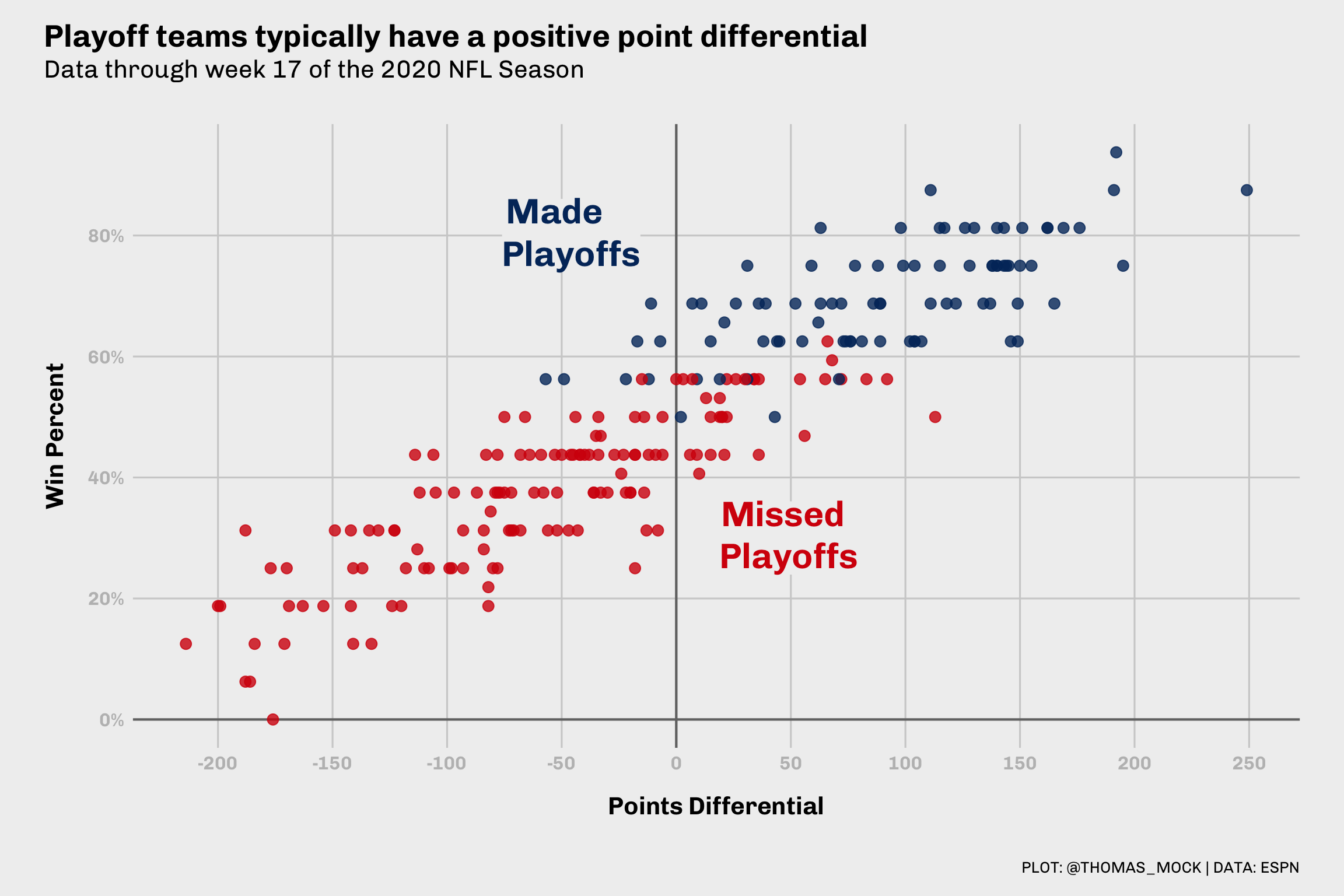
Same data, different story
library(ggridges)stand_density <- nfl_stand %>% mutate( color = case_when( season < 2020 & seed <= 6 ~ "#013369", season == 2020 & seed <= 7 ~ "#013369", TRUE ~ "#D50A0A" ) ) %>% ggplot(aes(x = pts_diff, y = factor(season), color = I(color), fill = I(color))) + geom_vline(xintercept = 0.5, size = 0.75, color = "#737373") + geom_density_ridges(alpha = 0.8, scale = 0.9) + theme_538()Same data, different story
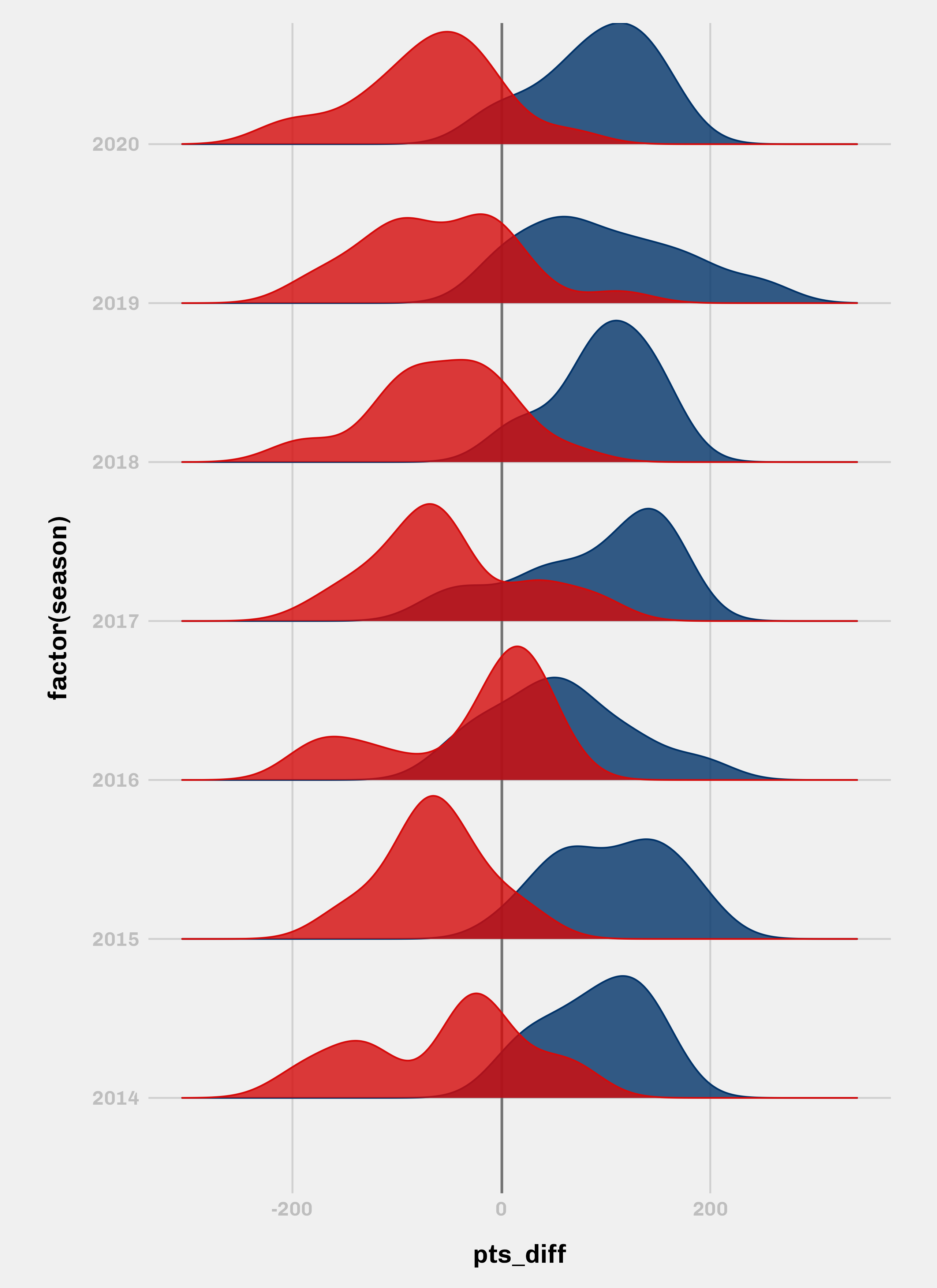
Same data, different story
# create a small dataset for the custom annotationsplayoff_label_ridge <- tibble( y = c(7.55, 7.55), differential = c(-250,175), label = c("Missed<br>Playoffs", "Made<br>Playoffs"), color = c("#D50A0A", "#013369"))stand_density + scale_x_continuous(breaks = scales::pretty_breaks(n = 10)) + coord_cartesian(xlim = c(-250, 250)) + ggtext::geom_richtext( data = playoff_label_ridge, aes(x = differential, y = y, label = label, color = color), fill = "#f0f0f0", label.color = NA, # remove background and outline label.padding = grid::unit(rep(0, 4), "pt"), # remove padding family = "Chivo", hjust = 0 , fontface = "bold", size = 6 ) + theme_538() + theme(panel.grid.major.y = element_blank()) + labs( x = "Point Differential", y = "", title = "Playoff teams typically have a positive point differential", subtitle = "Data through week 15 of the 2020 NFL Season", caption = "Plot: @thomas_mock | Data: ESPN" )Same data, different story

Same data, yet another story
stand_df <- nfl_stand %>% filter(season == 2020)stand_df %>% filter(seed <= 12 & season == 2020) %>% ggplot(aes(x = tidytext::reorder_within(team_abb, seed, conf), y = pts_diff)) + geom_col() + tidytext::scale_x_reordered() + facet_grid(~conf, scales = "free_x") + geom_hline(yintercept = 0, size = 0.75, color = "#737373") + theme_538()Same data, yet another story
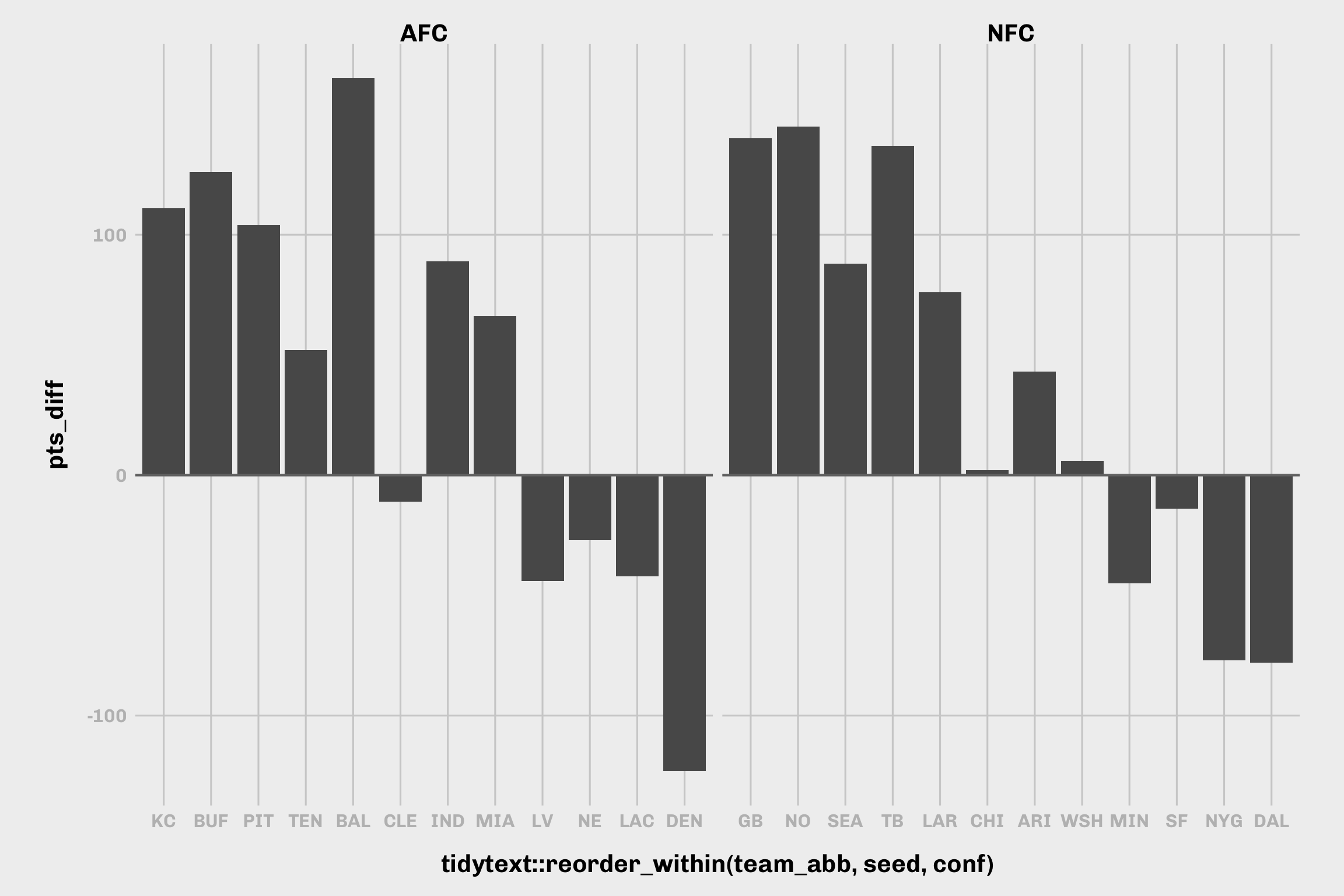
More context
# Small label datasetplayoff_label <- tibble( seed = c(9, 2), pts_diff = c(30, 145), conf = c("AFC", "AFC"), label = c("Outside<br>looking in", "Playoff<br>teams"), color = c("#D50A0A", "#013369"))More context
stand_df %>% filter(seed <= 12) %>% ggplot(aes(x = as.factor(seed), y = pts_diff)) + geom_col( aes(fill = if_else(seed <= 7, "#013369", "#D50A0A")), width = 0.8 ) + ggtext::geom_richtext( data = playoff_label, aes(label = label, color = I(color)), fill = "#f0f0f0", label.color = NA, # remove background and outline label.padding = grid::unit(rep(0, 4), "pt"), # remove padding family = "Chivo", hjust = 0.1, fontface = "bold", size = 6 ) + geom_hline(yintercept = 0, size = 0.75, color = "#737373") + geom_vline(xintercept = 7.5, size = 1, color = "grey") + geom_vline(xintercept = 0.5, size = 0.75, color = "#737373") + facet_grid(~conf, scales = "free_x") + scale_y_continuous(breaks = scales::pretty_breaks(n = 10)) + scale_fill_identity(aesthetics = c("fill", "color")) + theme_538() + theme(panel.grid.major.x = element_blank()) + labs( x = "Playoff Seed", y = "Points Differential", title = "Playoff teams typically have a positive point differential", subtitle = "Data through week 15 of the 2020 NFL Season", caption = "Plot: @thomas_mock | Data: ESPN" )More context
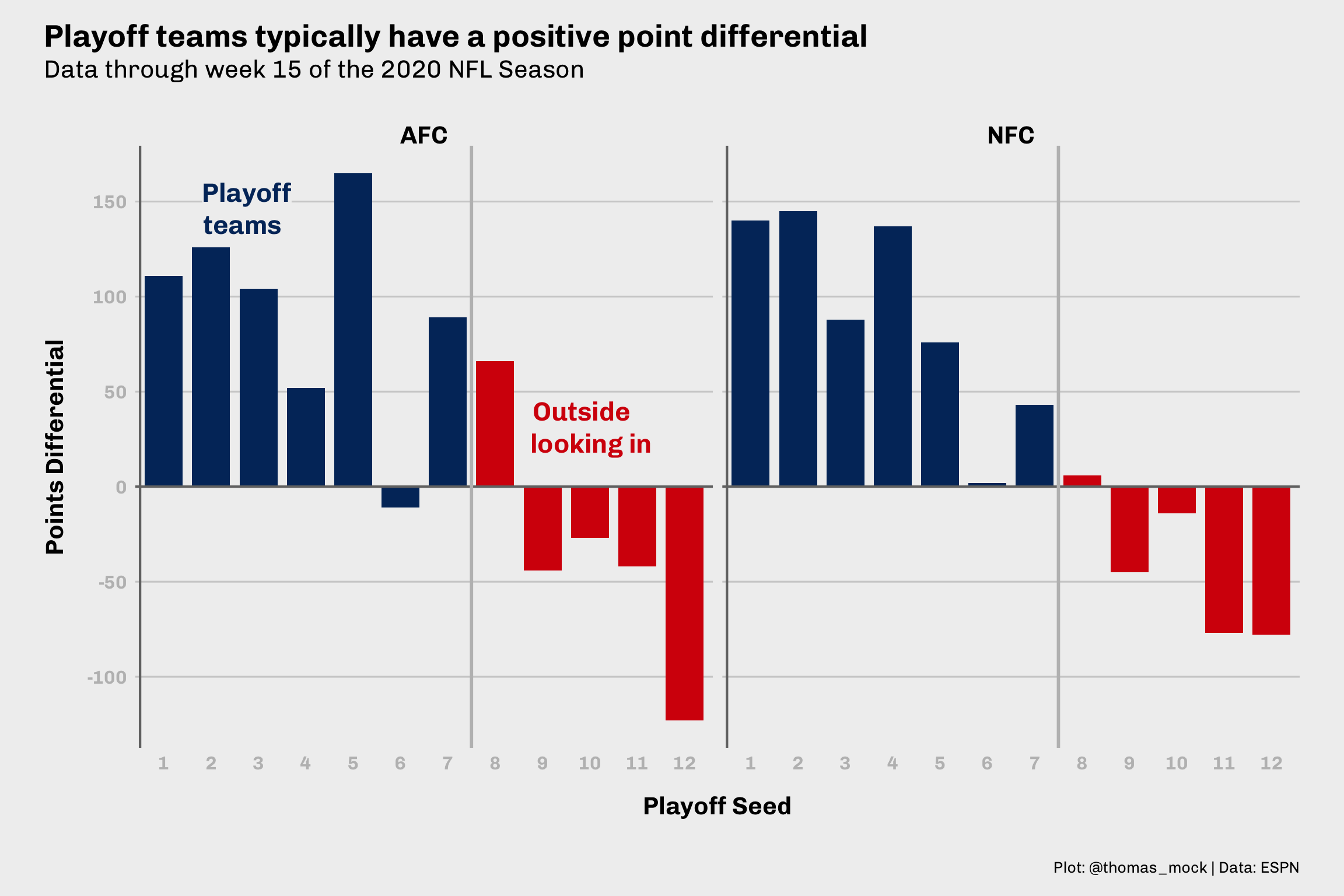
A true recreation
FiveThirtyEight article
The Indianapolis Colts Finally Built A Defensive Monster by Ty Schalter

Data for recreation
raw_url <- "https://www.pro-football-reference.com/years/2020/opp.htm"raw_html <- read_html(raw_url)raw_table <- raw_html %>% html_table(fill = TRUE) %>% .[[2]] %>% janitor::clean_names() %>% tibble()pressure_df <- raw_table %>% select(tm, blitz_pct = bltz_percent, press_pct = prss_percent) %>% mutate(across(c(blitz_pct, press_pct), parse_number))pass_def_raw <- raw_html %>% html_node("#all_passing") %>% html_nodes(xpath = "comment()") %>% html_text() %>% read_html() %>% html_node("table") %>% html_table() %>% janitor::clean_names() %>% tibble()pass_def_df <- pass_def_raw %>% select(tm, pass_att = att, int, pass_def = pd, sack = sk, ypa = y_a, anypa = any_a)Peek at the data
combo_pass <- left_join( pressure_df, pass_def_df, by = "tm")combo_pass %>% glimpse()## Rows: 32## Columns: 9## $ tm <chr> "Atlanta Falcons", "Buffalo Bills", "Carolina Panthers", "Ch…## $ blitz_pct <dbl> 32.9, 35.8, 24.0, 21.4, 31.1, 21.3, 17.1, 39.4, 22.8, 27.9, …## $ press_pct <dbl> 23.6, 22.2, 22.4, 22.4, 19.0, 21.9, 23.3, 25.9, 22.8, 26.2, …## $ pass_att <dbl> 625, 573, 585, 547, 541, 585, 562, 570, 513, 567, 557, 536, …## $ int <dbl> 12, 15, 7, 10, 11, 11, 15, 11, 10, 10, 7, 11, 3, 12, 16, 18,…## $ pass_def <dbl> 51, 76, 58, 71, 80, 74, 78, 57, 46, 64, 51, 74, 50, 60, 64, …## $ sack <dbl> 29, 38, 29, 35, 17, 38, 40, 48, 31, 42, 24, 41, 34, 18, 32, …## $ ypa <dbl> 7.9, 6.9, 6.9, 7.2, 7.3, 7.2, 7.3, 6.9, 7.4, 7.2, 8.5, 7.1, …## $ anypa <dbl> 7.4, 5.7, 6.6, 6.6, 7.2, 6.6, 6.1, 5.9, 7.1, 6.2, 8.6, 6.1, …Quick plot
A theme alone only gets you so far.
combo_pass %>% ggplot(aes(x = blitz_pct, y = press_pct)) + geom_point() + labs( x = "Blitz Rate", y = "Pressure Rate", title = "The Colts are pressuring QBs without much of a blitz", subtitle = "Blitz rate vs. pressure rate for each NFL defense, through Week 17\nof the 2020 season" ) + theme_538()Quick plot
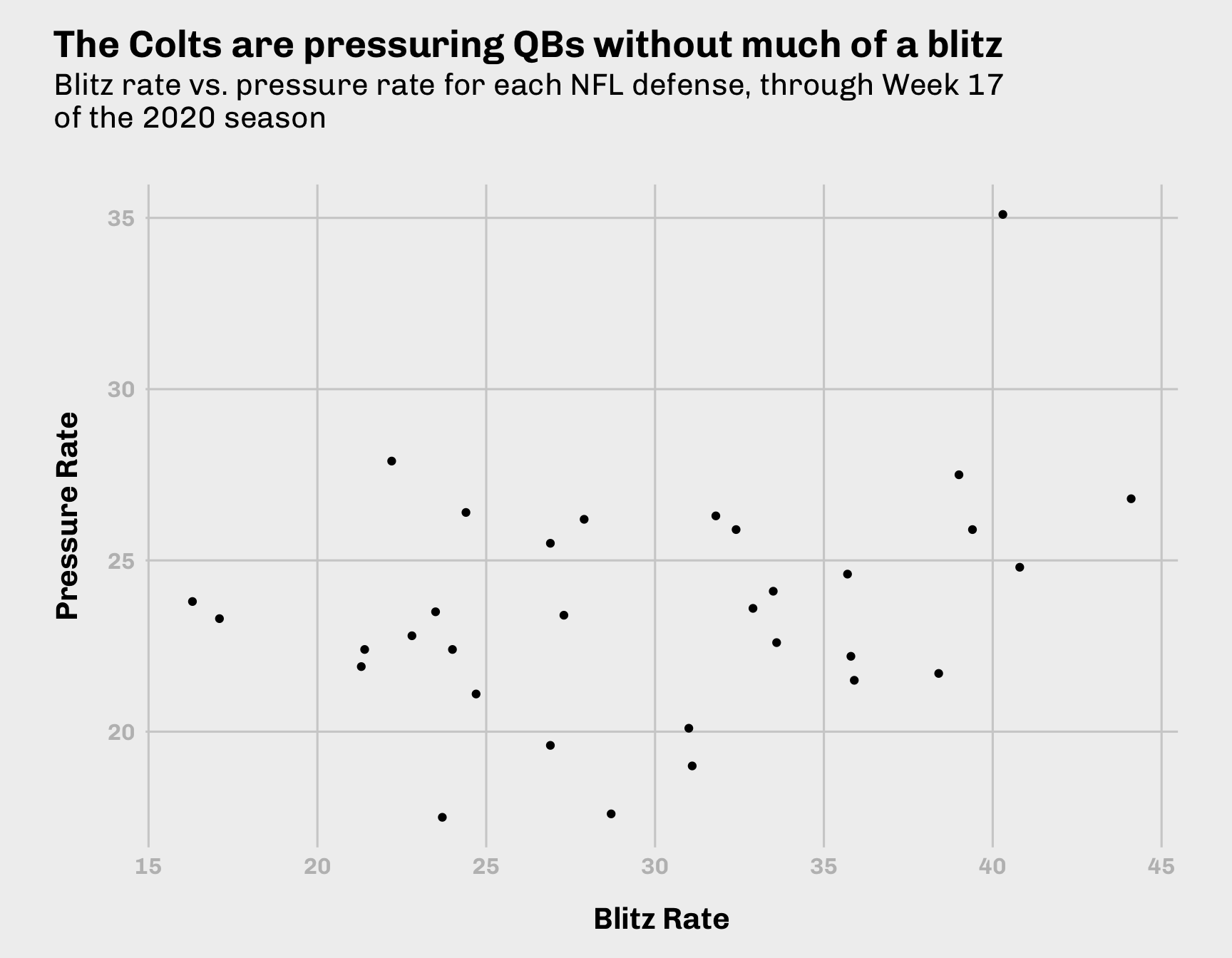
Color and Text
Prep the data, assign a color.
colt_df <- combo_pass %>% mutate( color = if_else(tm == "Indianapolis Colts", "#359fda", "#91c390"), fill = colorspace::lighten(color, amount = 0.3) ) %>% rowwise() %>% mutate( att_def = sum(int, pass_def, sack), cov_rate = att_def/pass_att*100 ) %>% ungroup() %>% arrange(desc(cov_rate))label_df_cov <- tibble( label = c("Colts", "Everyone else"), color = c("#359fda", "#91c390"), fill = colorspace::lighten(color, amount = 0.3), x = c(16, 33), y = c(25, 28))Color and Text
colt_df %>% ggplot(aes(x = blitz_pct, y = cov_rate, color = color, fill = fill)) + geom_point(size = 5, pch = 21) + scale_color_identity(aesthetics = c("fill", "color")) + labs( x = "Blitz Rate", y = "Pass Affected Rate", title = "The Colts affect passes at an elite rate while blitzing the least", subtitle = "Blitz rate vs. pressure rate for each NFL defense, through Week 17\nof the 2020 season", caption = "Plot: @thomas_mock | Source: PFR" ) + scale_x_continuous(limits = c(10, 45), breaks = seq(10, 45, by = 5)) + scale_y_continuous(limits = c(10, 35), breaks = seq(10, 35, by = 5)) + coord_cartesian(clip = "off") + annotate("text", x = 10, y = 10, label = "Pass affected rate = (ints + sacks + passes defended)/pass attempts", vjust = 10, hjust = 0.2, color = "darkgrey") + theme_538()Color and Text
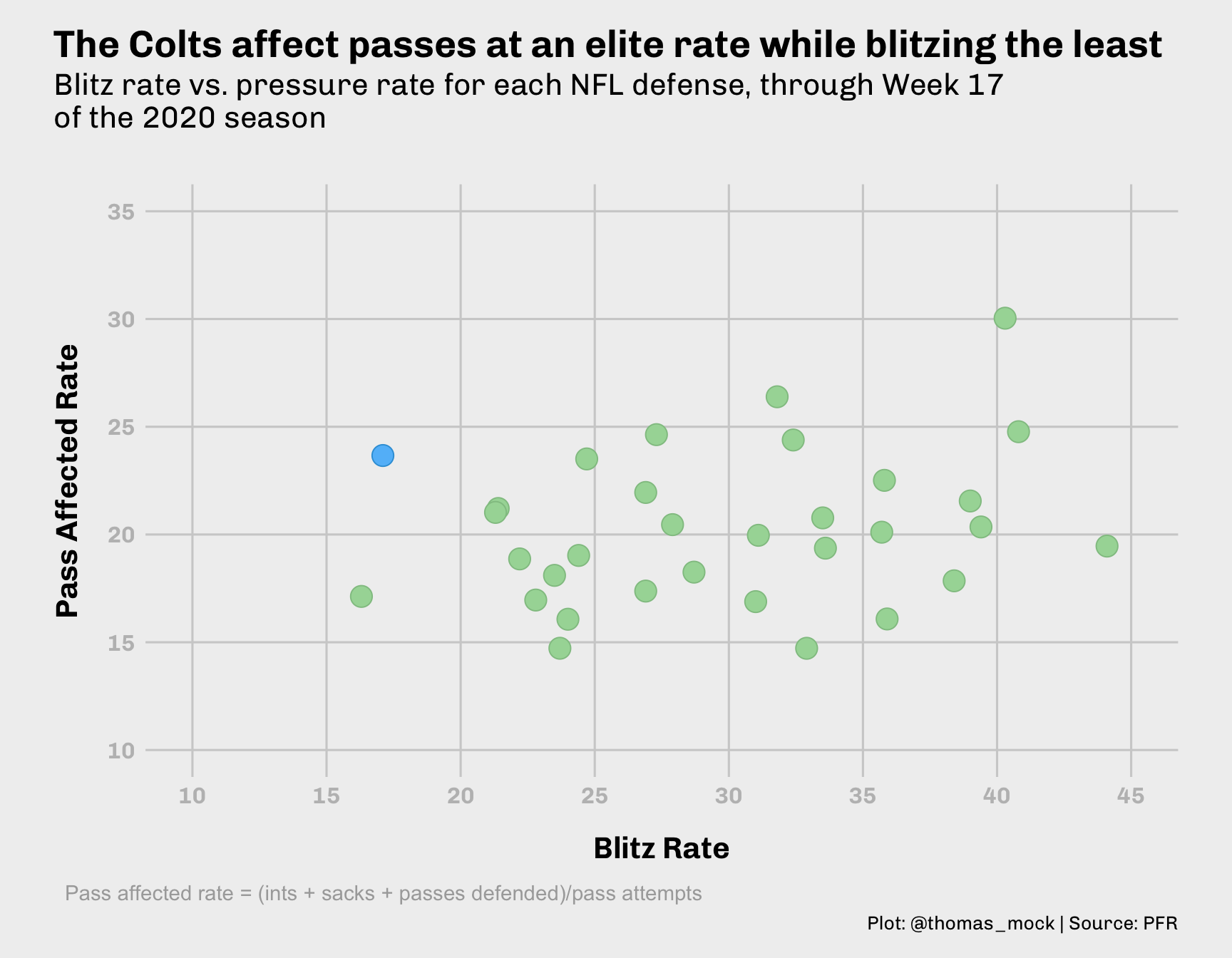
Color and Text, Labeled
colt_df %>% ggplot(aes(x = blitz_pct, y = cov_rate, color = color, fill = fill)) + geom_point(size = 5, pch = 21) + scale_color_identity(aesthetics = c("fill", "color")) + labs( x = "Blitz Rate", y = "Pass Affected Rate", title = "The Colts affect passes at an elite rate while blitzing the least", subtitle = "Blitz rate vs. pressure rate for each NFL defense, through Week 17\nof the 2020 season", caption = "Plot: @thomas_mock | Source: PFR" ) + scale_x_continuous(limits = c(10, 45), breaks = seq(10, 45, by = 5)) + scale_y_continuous(limits = c(10, 35), breaks = seq(10, 35, by = 5)) + coord_cartesian(clip = "off") + annotate("text", x = 10, y = 10, label = "Pass affected rate = (ints + sacks + passes defended)/pass attempts", vjust = 10, hjust = 0.2, color = "darkgrey") + theme_538() + geom_label( data = label_df_cov, aes(x = x, y = y, color = color, label = label), fill = "#f0f0f0", size = 6, fontface = "bold", hjust = 0.8, label.size = NA )Color and Text, Labeled
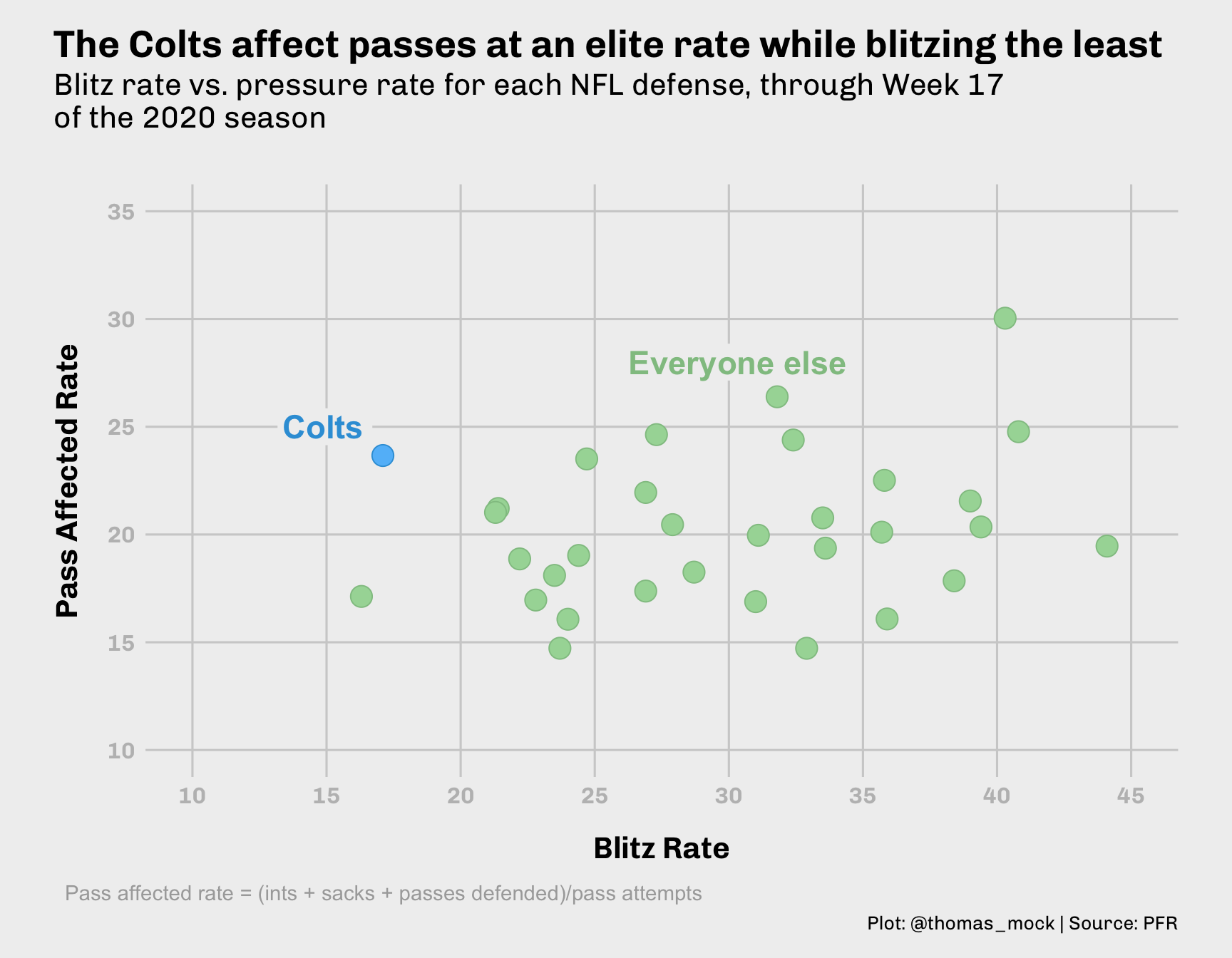
Back to the original

Summary
"Steal like an artist" for inspiration
Themes can make your customizations more consistent
Colors on top of that further extend the presentation
Annotations help tell a story
"Helper" datasets for annotations can speed things up
Direct labels save space and reader time